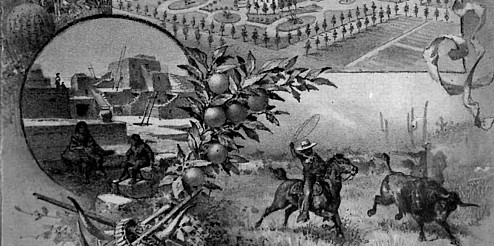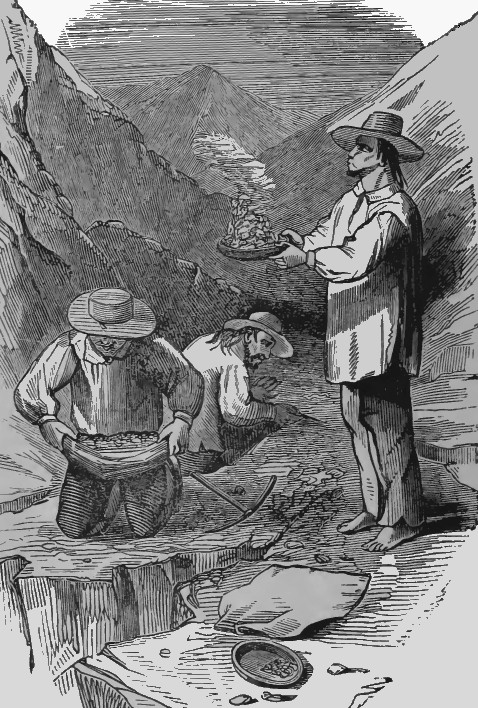Yuma, the county seat of Yuma county, is situated near the junction of the Gila with the Rio Colorado, and about twenty miles north of the Sonora line. On a commanding bluff, opposite the town, on the California side of the river, is Fort Yuma, built on the site of a mission established here by the Spanish fathers as early as 1771, and destroyed by the Yuma Indians ten years later. The first settlement at the site of the town of Yuma was made by Dr. Lincoln and others in 1849, who established a ferry over the Colorado to accommodate the thousands who flocked to the newly discovered gold region of California. An outbreak among the Indians destroyed the ferry and killed all the owners, except three persons. In 1850, the ferry, was again started by Don Diego Jaeger and others. This party were again attacked in 1851 by the Indians, who compelled them to abandon their enterprise and retreat back to California. In 1852, Heintzelman and Stoneman (both of whom afterwards rose to high commands in the civil war), marched across the Colorado desert with a detachment of United States troops, and established the post of Fort Yuma. The ferry was again started, and the village of Arizona City grew up around it. In 18G4, Yuma was made the distributing point for the military posts in Arizona, and advanced rapidly in
population and business. It contains several large stores, three hotels (one owned by the railroad company), a large wagon shop, blacksmith shops, saloons, etc. It has one public school with a daily attendance of 50. The Sisters of Charity have also a flourishing school at this place. The Territorial prison is situated here. It is a secure and roomy structure, built of stone, and situated on a bluff above the Colorado. The railroad company have built extensive shops at this point and give employment to a large number of men; they have also erected a tine bridge over the Colorado. The population is about 1,200.
Yuma has two newspapers, the Sentinel and the Arizona Free Press. The former is conducted by J. W. Dorrington, and sets forth the local news of its section in an attractive manner. The Free Press is owned and edited by Samuel Purdy, Jr. It is an interesting journal, conducted with marked ability, and has done much to bring to notice the resources of Yuma county. Yuma's situation at the junction of the two largest streams in the Territory, the rich mining country which lies to the north and east of it, and its unrivaled climate for those troubled with lung diseases, will always insure its permanency and prosperity. Many of the mines were rich and even under unfavorable circumstances yielded a large amount of bullion. Developments extended over a wide region, including mines of copper and gold as well as silver ores, especially in the east on the New Mexican border; and prospecting operations, often with great success, were extended to the upper and lower Gila and even into the unexplored regions farther north. Tucson recovered something of its old time prosperity; Tubac became a flourishing little town of some 500 inhabitants, where the first Arizona newspaper was published in 1858-60; a few ranchos were established, including several in the Gila valley on the stage route; and the American population increased to several thousands.
Fort Yuma, located on the eastern side of the Colorado, was occupied continuously by United States troops, affording much better protection to this part of Arizona than was enjoyed in the south-east. Steamers continued to ply on the Colorado; the ferry did a prosperous business; the overland stage had a station here; and much teaming was done in the transportation of supplies and copper ore to and from the copper mines in Papagueria and the silver mines by the Gila route. The settlement on the Arizona side known as Colorado City and Arizona City is often mentioned as a thriving town, as under the circumstances it should have been; but the more definite of current items reduce it to a very few buildings, mostly destroyed in the flood of the Gila some twenty miles above the junction, but extending for several miles along the river; and a new town of shanties sprang into existence, under the name of Gila City. Five hundred miners or more were at one time at work here, some of them very successfully; but there was great difficulty in getting water, the richest diggings being several miles from the river, and before 1862 the glory of these placers had departed, and the city was destroyed by the flood. There was no settlement north of the Gila, though prospecting was carried on in different directions, a few emigrants came over the Beale wagon road, and Fort Mojave, as we have seen, was garrisoned from 1858.For five or six years after the American occupation, the Indians caused comparatively little trouble, though constant vigilance was required, and petty depredations never ceased entirely. The Yumas, not a numerous tribe, were kept in control by the garrison and rarely molested Americans except as pilferers, though 1861-2. In 1858 gold placers were discovered on often in trouble with their neighbors. In 1857, with Mojave, Cocopa, and Tonto allies, they attacked the Pimas and Papagos up the river, and in a great battle were almost annihilated.
Return
to The Arizona Page:
Arizona Gold Rush Mining History



